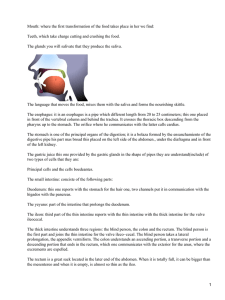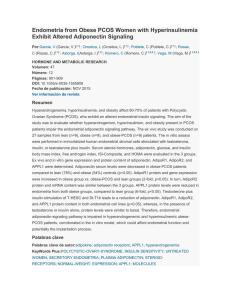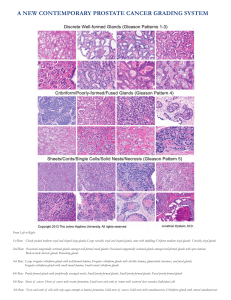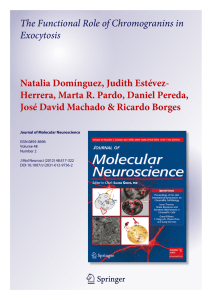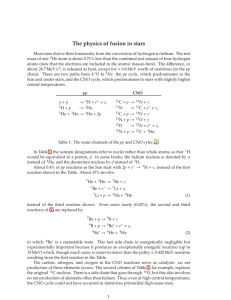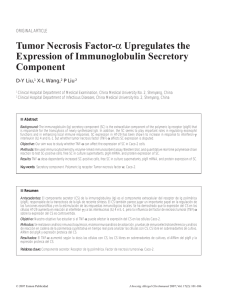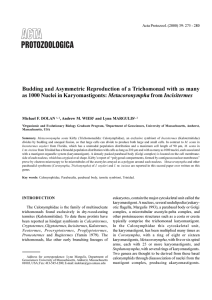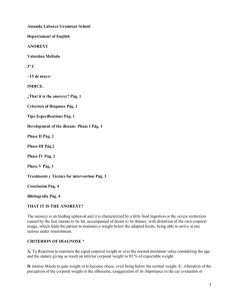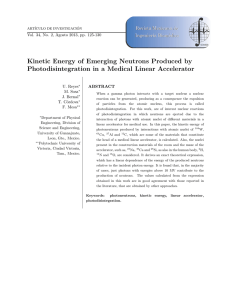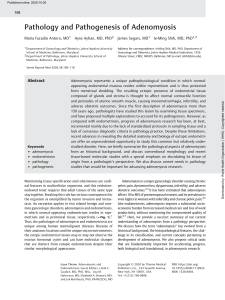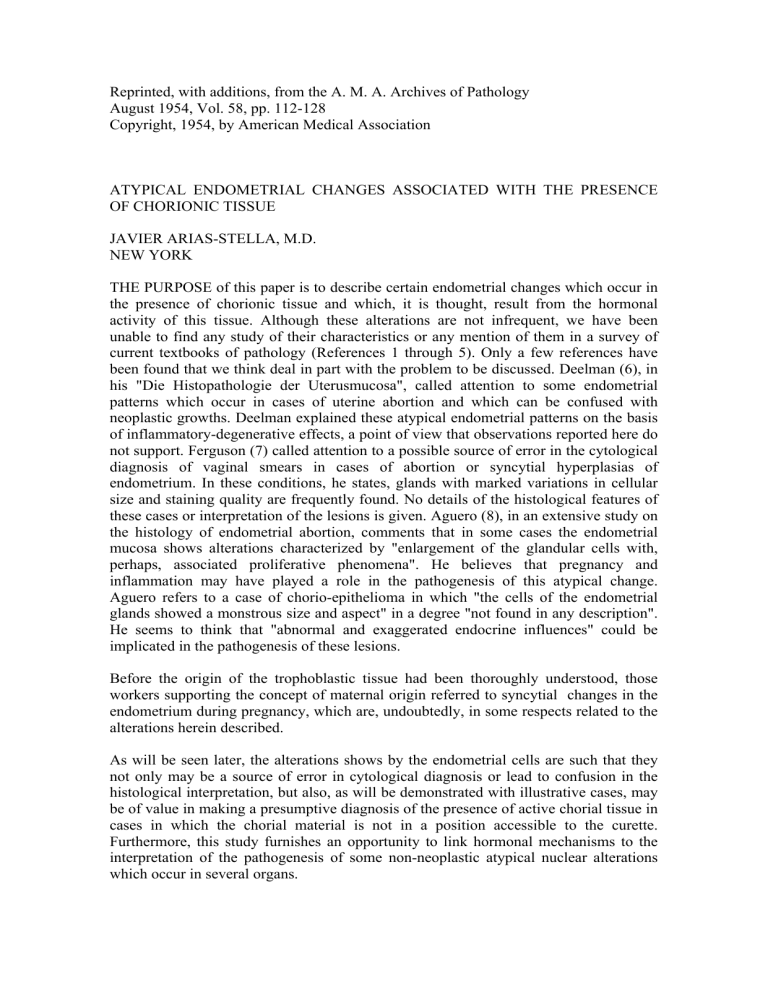
Reprinted, with additions, from the A. M. A. Archives of Pathology August 1954, Vol. 58, pp. 112-128 Copyright, 1954, by American Medical Association ATYPICAL ENDOMETRIAL CHANGES ASSOCIATED WITH THE PRESENCE OF CHORIONIC TISSUE JAVIER ARIAS-STELLA, M.D. NEW YORK THE PURPOSE of this paper is to describe certain endometrial changes which occur in the presence of chorionic tissue and which, it is thought, result from the hormonal activity of this tissue. Although these alterations are not infrequent, we have been unable to find any study of their characteristics or any mention of them in a survey of current textbooks of pathology (References 1 through 5). Only a few references have been found that we think deal in part with the problem to be discussed. Deelman (6), in his "Die Histopathologie der Uterusmucosa", called attention to some endometrial patterns which occur in cases of uterine abortion and which can be confused with neoplastic growths. Deelman explained these atypical endometrial patterns on the basis of inflammatory-degenerative effects, a point of view that observations reported here do not support. Ferguson (7) called attention to a possible source of error in the cytological diagnosis of vaginal smears in cases of abortion or syncytial hyperplasias of endometrium. In these conditions, he states, glands with marked variations in cellular size and staining quality are frequently found. No details of the histological features of these cases or interpretation of the lesions is given. Aguero (8), in an extensive study on the histology of endometrial abortion, comments that in some cases the endometrial mucosa shows alterations characterized by "enlargement of the glandular cells with, perhaps, associated proliferative phenomena". He believes that pregnancy and inflammation may have played a role in the pathogenesis of this atypical change. Aguero refers to a case of chorio-epithelioma in which "the cells of the endometrial glands showed a monstrous size and aspect" in a degree "not found in any description". He seems to think that "abnormal and exaggerated endocrine influences" could be implicated in the pathogenesis of these lesions. Before the origin of the trophoblastic tissue had been thoroughly understood, those workers supporting the concept of maternal origin referred to syncytial changes in the endometrium during pregnancy, which are, undoubtedly, in some respects related to the alterations herein described. As will be seen later, the alterations shows by the endometrial cells are such that they not only may be a source of error in cytological diagnosis or lead to confusion in the histological interpretation, but also, as will be demonstrated with illustrative cases, may be of value in making a presumptive diagnosis of the presence of active chorial tissue in cases in which the chorial material is not in a position accessible to the curette. Furthermore, this study furnishes an opportunity to link hormonal mechanisms to the interpretation of the pathogenesis of some non-neoplastic atypical nuclear alterations which occur in several organs. MATERIAL The present study is based on pathological material from 182 cases of uterine abortion, 26 cases of hydatidiform mole, 14 cases of chorioepithelioma, and 4 cases of syncytial endometritis. Reference will be made also to one case of ectopic pregnancy. The material has been taken from the files of the Department of Anatomical Pathology of the Faculty of Medicine of Lima and from the Pathology Laboratories of Memorial Center for Cancer and Allied Diseases of New York. For the most part, routine slides have been used, but in a few cases additional sections were prepared. All the slides were stained with hematoxylin and eosin. UTERINE ABORTION Secretory activity and decidual reaction are the fundamental endometrial changes related to the presence of placental tissue. Referring to the endometrial alterations during pregnancy, Novak (5) says: In the event of pregnancy the hypertrophic and secretory changes of the pregravid phase become even more marked, so that there is an insensible transition between the premenstrual picture in the nonpregnant woman and the very early decidua of the woman in whom the ovum has been fetilized. In fact, it is not always easy to make the distinction in the laboratory unless embryonic elements, such as villi, are present in the section. The glands of the decidua present marked saw-tooth convolution and scalloping, and the epithelium is low, pale-staining, and actively secretory. At a little later stage the tortuosity of the glands is much less and the epithelium becomes very flat, so that there may be difficulty in distinguishing the glands from lymphatics or venules. The same author, when discussing the histology of postabortive endometritis, states: What has been said as to the qualified significance of the decidual cells applies even more to the gland pattern. Here again the predecidual reaction of the non pregnant woman may produce a high degree of tortuosity and secretory activity of the glands, so that they cannot be distinguished from those of very early pregnancy. The present study demonstrates that frequently in cases of abortion there are not only epithelial and glandular changes which are an exaggeration of the normal secretory phase but, in addition, alterations with certain specific characteristics which do not occur in the normal endometrial phases. It is common, for instance, in most of the cases showing viable chorionic tissue to find markedly secretory endometrium which on close examination reveals in some glands the presence of groups of cells that are larger than their neighbors. This cellular enlargement exceeds the normal variations occurring in the endometrial cycle and is due, principally, to a nuclear hypertrophy. When this change in size is slight, it occurs more frequently in the vicinity of zones of implantation, and minimal or mild alterations are easily overlooked. In other cases, however, the cellular enlargement is both marked and widespread, although the more accentuated changes always tend to occur focally. These focal alterations are the ones which will be described in some detail. Secretory change, usually exaggerated, with simultaneous proliferative activity of variable degree and cellular enlargement, principally of the nuclei, are main histological features which occur in these areas displaying maximum change. When extreme secretory activity is combined with an equally great proliferative effect, one see groups of glands with very vacuolated, foamy cells, which are practically without lumens (Figs. 1 trough 4). Here and there are cells with hypertrophic nuclei, sometimes monstrously enlarged and hyperchromatic. Usually these enlarged nuclei show variations in shape, some being lobulated or elongated while others assume more bizarre forms. In some fields the hypertrophic nuclei are predominant, but in others they are less conspicuous, and here the secretory and proliferative changes are outstanding. When the secretory activity is mild or moderate but the proliferative effect intense, cellular masses are formed which by fusion of their cytoplasm develop a syncythial appearance. As in uterine abortion, there is almost always an associated endometritis, and the presence of inflammatory cells, exudate, and secondary alterations lead to the interpretation that the gigantic nuclei may result from secondary degenerative phenomena. It seems, indeed, that when intensive, the inflammation does influence the histological pattern, contributing to glandular distortion and increased nuclear stainability. A careful analysis, however, of early and intermediate phases of the process in cases free from inflammatory changes leads to the conclusion that the nuclei become hypertrophic primarily for reasons other than the inflammatory degenerative reactions. The concomitant intensive secretory and proliferative activities suggest, rather, a unique form of overstimulation. In some cases nuclear enlargement occurs in glands which are histologically closer to the normal proliferative pattern, in other words, in glands with minimal or no secretory activity. The nuclear membrane is then well defined, and the more or less dispersed chromatin is clearly shown (Fig. 5). It is possible to see in one part of a gland some evidence of secretion and in another part frankly proliferative activity and cells with enlarged nuclei. It may have to be stressed that by enlarged nuclei is meant nuclei of sizes which are not present in the phases of the normal endometrial cycle. Another interesting feature observed in these glands is the loss of cellular polarity. The nuclei lie without any orientation, in the most disorderly and capricious ways. A single hypertrophic nucleus may occur between others having normal appearance. As has been previously said, these changes usually occur focally. However, the alterations can occasionally be the dominant pattern throughout a given section. When the changes mentioned are minimal, there may be no cellular reduplication or notable secretory activity, and only the presence of some pyknotic, hypertrophic nuclei is observed (Fig. 6). The surface epithelium can undergo similar change, enlarged cells occasionally being present at this level. As a rule, the remainder of the endometrium shows a secretory or mixed pattern, with areas of definite proliferative change. The stroma displays a variable degree of decidual reaction. In the cases with marked change, there is frequently an intensive decidual reaction and the presence of decidual giant cells. In those instances in which there were striking alterations, it was the rule to find viable chorionic villi with a variable degree of focal proliferation of the trophoblastic layers. In none of the cases showing the more impressive changes were the alterations associated with the presence of completely atrophic, fibrosed, or hyalinized villi. When there was a minimal chorial activity, the changes were correspondingly less in degree. A history of metrorrhagia occurring 20 to 60 days prior to the curettage was usually elicited in those cases showing marked changes. Very conspicuous endometrial alterations occurred in 20 of the 182 cases studied. When one studies the endometrium immediately after an abortion, he may find the glandular alterations discussed here in the absence of villi. It is evident, therefore, that the endometrial changes described may serve as a diagnostic clue in this clinical setting. ECTOPIC PREGNANCY A review of the reported findings in the endometrium associated with ectopic pregnancy (References 9 through 11) reveals that no particular attention has been focused on the occurrence of cellular and glandular changes described in the preceding section. That this does happen is demonstrated by the following case. Z. F., 34 years of age, was admitted to the Loayza Hospital of Lima on Oct. 26, 1950, complaining of slight metrorrhagia since her last menstruation, Oct. 4. Physical examination revealed a moderately anemic patient with hemorrhagic vaginal discharge, enlarged uterus, and painful left adnexa, in which an elongated mass was palpated. A partial hysterectomy, with removal of both tubes and ovaries, was performed on Oct. 31. Pathological study revealed an ectopic pregnancy in the left tube. The chorionic villi were lined by both trophoblastic layers and showed occasional areas of slight syncytial proliferation. A large, mature corpus luteum was present in the left ovary. The uterus showed no striking gross change. The histological examination was, however, of interest. The endometrial glands presented a mixed and atypical pattern. In areas the glands were of a definite proliferative type, with tall cells showing deep-staining nuclei, marked reduplication, and numerous mitoses. In other zones, but to a much smaller extent, the glandular pattern was frankly secretory, with vacuolated cells, marked infolding, and intraluminal budding. Gland dilatation with formation of cysts was also noted. Large or limited portions of the glands in these areas presented atypical cellular changes. These portions were characterized by a cellular enlargement due to nuclear hypertrophy and cytoplasmic vacuolation. The cells appeared deformed and filled with vacuoles of different diameters and in more advanced stages showed breakdown of the protoplasmic membrane. The nuclei were enlarged to from three to four times the size of the normal cells and were round, ovoid, vesicular, or capriciously distorted (Figs. 7 through 9). The chromatin was hyperchromatic and condensed in thick bars or granules. Rarely, a nucleolus was seen in the enlarged atypical cells. In the same gland, it was possible to see all transitions from the normal cells to those slightly altered or very atypical. It was common to find areas in which the atypical cells had proliferated and formed several layers with loss of nuclear polarity. The cellular reduplication tended to be directed toward the lumens. Syncytial masses of vacuolated cells were also formed (Fig. 10). The nuclear hypertrophy was better demonstrated in those areas showing less secretory effect (Fig. 11). Occasionally, mitoses were seen in the atypical cells. The stroma was mostly cellular and dense, as in the normal proliferative phase; in rare areas it was slightly edematous. No evidence of decidual reaction was found. Occasional foci of mononuclear cell infiltration were noted. The changes described involved the surface and medial portions of the endometrium. In the deep zone they were minimal or absent. Several interesting points can be deduced from this case. The nuclear enlargement, as well as the proliferative and secretory changes, was readily apparent. In view of the absence of conspicuous inflammation, the possibility of its playing a role in the genesis of the changes is unlikely. In addition, this case clearly indicates that for the production of the glandular alterations, it is not necessary that chorial tissue be present in the uterus itself. This suggests, rather, a humoral influence. Since the stroma revealed no trace of decidual transformation, this case shows that the glandular alteration can be dissociated from its occurrence in the uterus. Finally, in this case the uterus was studied in the absence of significant manipulation, which is not the case in the usual specimen of endometrial abortion. Hence, the possible influence of endometrial trauma may be excluded. A reinvestigation of the endometrium in ectopic pregnancy directed to verifying the frequency of this kind of change is desirable. HYDATIDIFORM MOLE AND CHORIOEPITHELIOMA Changes similar to those previously described occur also in the endometrium in cases of benign hydatidiform mole, in the so-called chorioadenoma destruens, and in cases of chorioepithelioma. Here, too, were found varying degrees of alterations, ranging from cases in which the glandular lesions were more or less diffuse throughout the endometrium to those in which the change was limited to a single focus. In six cases of chorioadenoma destruens, three of benign hydatidiform mole, and two of chorioepithelioma, endometrial changes of impressive degree were found. In one case of chorioadenoma destruens, six cases of benign hydatidiform mole, one case of chorioepithelioma, and two of syncytial endometritis, they were moderate or slight. The secretory component was present in variable proportions but was, as a rule, moderate and not so prominent as in the cases of abortion. Here, on the contrary, the proliferative change and nuclear enlargement may be remarkable, giving rise in instances to problems of interpretation. As a matter of fact, our attention to this whole problem was directed by the following case, illustrative of the alterations found in this group. A. A., 24 years old, had a spontaneous abortion in Jan. 1949, delivering a hydatidiform mole al the Maternity Hospital of Lima. In the latter part of May, 1949, the patient complained of metrorrhagia, which increased in intensity, necessitating hospitalization on June 11, when she entered the Loayza Hospital of Lima. On admission, she was markedly anemic, and the gynecological examination disclosed a slightly enlarged uterus. On June 18, a Galli Mainini reaction (frog test) was strongly positive, suggesting the presence of chorial tissue. Thereafter, a curettage was performed. This failed to reveal any chorial tissue in the uterine cavity. The glands were of secretory type, with moderate infolding. The stroma was edematous, but no trace of decidual reaction was seen. The striking alteration consisted of a disorcerly cellular enlargement of individual cells, or groups of them, involving practically every gland. The hypertrophied nuclei were intensely hyperchromatic and of variable forms. In general, the cells were arranged in one row, but in areas there was slight reduplication. The cytoplasm showed moderate vacuolation (Fig. 12). At that time we were unable to arrive at any conclusion concerning the endometrial changes, and no definite diagnosis could be given. Nevertheless, on the basis of the positive biological test and the antecedent of molar abortion, a hysterectomy was performed seven days after the curettage. The pathological study revealed a uterus 9 cm. in length and 5 cm. in transverse diameter. In the anterior and right lateral walls, there were several well-defined, somewhat friable, hemorrhagic nodules, situated intramurally, without relation to the endometrium. The largest of these nodules measured 1.5 cm. A large mature corpus luteum was present in each ovary. The histological examination of the uterus showed that the nodules were nests of chorial tissue with proliferation of syncytial and Langhan's cells intermingled with hydropic chorial villi. Invasion of the myometrium in the vicinity of the nodules, necrosis, and tumor permeation into the vessels were noted. In general, the pattern was that of molar rests, with marked intramural penetration and moderate trophoblastic proliferation. In its entirety, the endometrium presented an abnormal pattern. The glands showed mostly a proliferative pattern, but in areas they were slightly dilated and moderately hyperplastic, and in a very few fields minimal evidence of secretory effect could be demonstrated. In the areas showing a normal proliferative type of reaction, the cellular reduplication in the glands and the mitotic activity were intense (Fig. 13). The striking change consisted of a tremendous cellular enlargement of isolated cells involving most of the glands (Figs. 14 through 18). This enlargement was due basically to hypertrophy of the nuclei, which appeared intensely hyperchromatic, vesicular, lobulated, or bizarre in shape. Aggregations of enlarged, proliferated glandular cells were frequently seen, in which mitosis could be detected only occasionally. In the cell accumulation, the presence of gigantic, monstrous nuclei was striking. In areas the impression was obtained that these nuclei were the result of some form of swelling, but in others definite increase in the chromatin with well-defined nuclear outlines was apparent. In the dilated glands, epithelial desquamation and amorphous intraluminal secretion were noted. Throughout, the stroma was cellular, rather dense, and without trace of decidual reaction. Only occasional minute foci of mononuclear infiltration were seen. In no area was invasion of the endometrium by trophoblastic cells observed. Figures 19 through 26 show similar changes in others cases. It should be observed that the changes can occur independently of the decidual reaction and inflammation. Although our report is based on study of routine slides and, therefore, does not furnish appropriate material for a definite statement, it is our impression that in some cases, even with a marked degree of trophoblastic activity, these changes may be absent. At least in one case of hydatidiform mole and one of chorioepithelioma, representative areas of endometrium were available for study in which no conspicuous alteration was seen. We cannot, at the present time, establish the reasons for these differences. It is possible that the degree of hormonal activity would be one explanation. It can be pointed out that these changes may, besides the importance of their pathogenetic interpretation, have practical value, as demonstrated in the case related. It is well known that on occasions the nodules of chorioadenoma destruens or chorioepithelioma can be intramurally situated, out of the sphere of the endometrial biopsy. An indirect proof of the presence of active chorial tissue can be obtained by the finding of lesions such as those described in the endometrium. This is more significant if we recall that the biological tests, undisputedly the more valuable diagnostic tools, can be, on occasion, of a low, dubious titer, or even negative, in the presence of hydatidiform mole or chorioepithelioma (References 12 and 13). COMMENT We have described the different modalities of some endometrial changes associated with the presence of active chorial tissue in the uterus or in other locations. Fundamentally, the alterations are characterized by an irregular nuclear hypertrophy of glandular cells and a variable proliferative activity. As we have seen, the proliferative phenomena occur even in the presence of a diverse degree of secretory effect. It seems that these changes are unrelated to the decidual reaction of the endometrium, as they have been seen in the presence or the absence of this type of stroma. Similar alterations have not been observed in the phases of the normal endometrial cycle. Although in some cases the changes are diffuse and very conspicuous, as a rule they are focal and in instances so discrete that they can be found only after a specific search for them. Frequently, the lesions are more or less masked by the inflammation. However, when one is familiar with the change, it is easy to recognize the subordinate role played by this factor in the histological picture. The presence of active or proliferative chorial tissue has been the common denominator in all the cases showing distinct changes. However, it is important to recall that it appears that marked trophoblastic proliferation is also possible without associated endometrial alteration. The focal pattern of the lesion is not surprising, since it is well known that even in the normal endometrium we are apt to find areas of different responsiveness to hormonal stimulation (5). Our study does not allow a definite statement to be made about the pathogenesis of the changes described. From the illustrations in this paper, it appears clear that they cannot be explained as inflammatory or degenerative. As we have shown, they can occur when the inflammation is minimal or absent. The invariable presence of active chorial tissue suggests immediately a relation to the pathogenesis. It seems provocative to postulate that the chorionic hormones and estrogens would be, in some way, responsible. The proliferative and secretory activities are likely to be the result of the kind of action which normally produces these effects. It seems that there is some factor interfering in the process of interphasic growth, with resultant formation of gigantic polyploid nuclei. Since only appropriate experimental evidence can shed definite light on this problem, we avoid, at this time, a more detailed discussion of the probable pathogenetic mechanism involved. We have been impressed by the similarity of the phenomena of nuclear enlargement in some of our cases and the changes produced in the normal endometrium after irradiation. Here, the nuclear hypertrophy is very conspicuous, and even proliferative activity in the glands can be detected. We cannot elaborate further on the meaning of this similarity, we merely mention the observation. In several organs connected with the endocrine system, nuclear alterations of benign character, usually characterized by marked hypertrophy, occur frequently (thyroid, parathyroid, seminal vesicles, etc.). On the basis of the observations here reported, it would appear advisable to study the possibility of hormonal actions as responsible for those changes. SUMMARY A description of some atypical endometrial patterns occurring in the presence of chorionic tissue in the uterus or in other anatomical locations is given. The alterations are characterized by an irregular nuclear hypertrophy of isolated glandular cells, usually accompanied by a marked proliferative activity, together with simultaneous secretory change of variable degree. The alterations tend to occur focally and are apparently unrelated to the decidual reaction of the stroma. The chorionic tissue was present as placental rests showing viable villi, benign hydatidiform mole, chorioadenoma destruens, or chorioepithelioma. The enlarged atypical nuclei frequently display a gigantic size, and the resultant histological pattern is one never seen in the normal endometrium and in extreme cases may give rise to a problem of interpretation, among the possible diagnoses being the suspicion of carcinoma. It is apparent that desquamation of these atypical nuclei may lead to error in the cytological diagnosis of vaginal smears. The alterations are, on the other hand, a histological clue to the presumptive diagnosis of the presence of active chorial tissue in those cases in which the chorionic material is not in a position accessible to curettage in the endometrial biopsy. It is suggested that the atypical endometrial pattern may result from the hormonal activity of the chorionic tissue. I acknowledge my indebtedness and express my thanks to Dr. F. W. Stewart, Dr. F. W. Foote, and Dr. R. C. Mellors for their assistance in the preparation of this paper. I wish also to thank Dr. S. Spitz for showing me several cases of endometrial abortion which added much to my understanding of the lesions here reported. REFERENCES 1. Ackerman, L. V.: Surgical Pathology, St. Louis, C. V. Mosby Company, 1953. 2. Anderson, W. A., Editor, Pathology, Ed. 2, St. Louis, C. V. Mosby Company, 1953. 3. Boyd, W.: Text-Book of Pathology: Introduction to Medicine, Ed. 6, Philadelphia, Lea & Febiger, 1953. 4. Herburt, P. A.: Gynecological and Obstetrical Pathology, Philadelphia, Lea & Febiger, 1953. 5. Novak, E.: Gynecological and Obstetrical Pathology with Clinical & Endocrine Relations, Ed. 3, Philadelphia and London, W. B. Saunders Company, 1952. 6. Deelman, H. T.: Die Histopathologie der Uterusmucosa, Leipzig C. 1., Georg Thieme, 1933. 7. Ferguson, J. H.: Some Limitations of Cytological Diagnosis of Malignant Tumors, Cancer 2:845-852, 1949. 8. Aguero, L.: Histopatología de los restos de aborto: I. (la decidua y sus alteraciones), Cirug. gynec. y urol. Madrid 1:278-312, 1950. 9. Hinz, W., and Terbruggen, A.: Extrauterinegraviditat und Mucosa uteri, Arch. Gynak. 182:230-250, 1952. 10. Meinrenken, H.: Zur Frage der Ruckbildung der Uterusschleimhaut bei lebender und abgestorbener Extrauteringraviditat, Geburtsh. u. Frauenh. 12:602-610, 1952. 11. Romney, S. L.; Hertig, A. T., and Reid, D. E.: Endometria Associated with Ectopic Pregnancy: Study of 115 Cases, Surg., Gynec. & Obst. 91:605-611, 1950. 12. Burrows, H.: Biological Actions of Sex Hormones, Ed. 2, New York, Cambridge University Press, 1949. 13. Thompson, R.; Gross, S., and Straus, R.: Chorionepithelioma of Uterus Associated with Temporarily Negative Biologic Tests for Chorionic Gonadotrophic Hormones, Am. J. Obst. & Gynec. 61:930-933, 1951. LEYENDAS DE FIGURAS Fig. 1 (Loayza Hospital, # 7001) .- Endometrial abortion. Focus of atypical change. Marked secretory activity, cellular reduplication, and nuclear hypertrophy are shown. X 98. Fig. 2 (another field from # 7001) .- Note the contrast between a normal gland, in the lower left corner, and the altered glands. X 98. Fig. 3 (Loayza Hospital, # 7001) .- Enlarged hyperchromatic nuclei are seen. X 200. Fig. 4 (Loayza Hospital, # 7001) .- Nuclear enlargement, cellular reduplication, and secretory activity are demonstrated. A distinct mitosis can be noted. X 600. Fig. 5 (Loayza Hospital, # 2301) .- Endometrial abortion. Nuclear enlargement in gland of proliferative type. X 440. Fig. 6 (Loayza Hospital, # 7590) .- Endometrial abortion. Minimal secretory activity, discrete nuclear enlargement, and mitosis are present. X 320. Fig. 7 (Loayza Hospital, # 2120) .- Tubal pregnancy. General aspect of the endometrium. Proliferative and cystic dilated types of glands showing occasional enlarged atypical nuclei can be seen. Observe absence of decidual change. X 84. Fig. 8 (Loayza Hospital, # 2120) .- Another view in greater magnification, showing the bizarre, atypical nuclei dispersed in disorderly fashion in practically all the glands in this field. Note loss of polarity. Fig. 9 (Loayza Hospital, # 2120) .- Another view, showing nuclear change and moderate secretory activity. Fig. 10 (Loayza Hospital, # 2120) .- Gland showing marked secretory effect, nuclear enlargement, and cellular reduplication, with slight syncytial tendency. X 480. Fig. 11 (Loayza Hospital, # 2120) .- Gland showing single gigantic nucleus. X 440. Fig. 12 (Loayza Hospital, # 419) .- Endometrial biopsy specimen. Scattered enlarged pyknotic nuclei in glands showing secretory pattern. Note edematous stroma without decidual reaction. See text. Fig. 13 (Loayza Hospital, # 419) .- Surgical specimen. Areas of endometrium showing normal proliferative pattern. Fig. 14 (Loayza Hospital, # 419) .- Gland showing atypical proliferative pattern. Cellular reduplication, loss of polarity, and marked nuclear enlargement are present. Figs. 15, 16, 17, and 18 (Loayza Hospital, # 419) .- Glands showing different aspects of the atypical proliferative pattern. Gigantic nuclei are prominent in all the photomicrographs. Fig. 19 (Memorial Hospital, # L-800) .- Chorioadenoma destruens. General view of the endometrium, showing scattered, moderately enlarged nuclei in several glands. Stroma shows no trace of decidual reaction. X 98. Fig. 20 (Memorial Hospital, # L-800) .- Gland showing an atypical gigantic nucleus between normal cells. There is slight secretory activity. X 440. Fig. 21 (Loayza Hospital, # 1000) .- Chorioadenoma destruens. Glands show several atypical enlarged nuclei. X 312. Fig. 22 (Loayza Hospital, # 1000) .- Another gland presenting similar aspect to that in Figure 21. X 440. Fig. 23 (Loayza Hospital, # 1083) .- Benign hydatidiform mole. Single hypertrophic, atypical nucleus in gland showing moderate secretory activity. X 440. Fig. 24 (Memorial Hospital, # 52-3874) .- Chorioadenoma destruens (?). Single wellpreserved, enlarged, active nucleus is demonstrated. X 440. Fig. 25 (Memorial Hospital, # L-531) .- Chorioadenoma destruens. Nuclear enlargement in secretory glands; marked decidual reaction. X 230. Fig. 26 (Memorial Hospital, # P-6668) .- Chorioepithelioma. Gigantic nucleus and evidence of proliferative activity. X 400.
